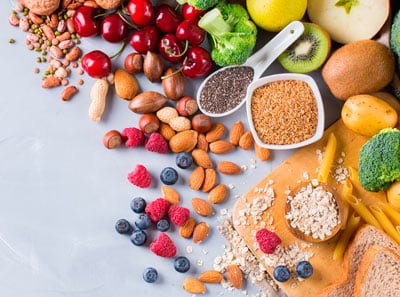
Cholesterol: foods that help keep it in check
Do you feel you need to look after yourself more? Are you concerned about the health of your heart? There is still time to learn what you should include in your diet routine to help prevent cholesterol or reduce its levels.
Cholesterol and Cardiovascular disease.

The pace of life today often prevents us from paying the necessary attention to the intake of fat-free foods harmful to health. Being careful and regular blood cholesterol checks will help reduce the risk of suffering from cardiovascular diseases which can lead to severe consequences such as heart attack, stroke or heart attack.
Being aware of the care of our heart is essential and it should begin not at adulthood, but rather when we are children and teenagers. In order to take care of our diet and habits we can start by reducing our intake of saturated fats, doing regular physical exercise and increasing our intake of foods such as vegetables, nuts, seeds, whole grains, vegetables and fruit.
Let us talk a little more about cholesterol..
What is Cholesterol?
When we talk about the word cholesterol, the consumption of unhealthy food and the daily routine of a sedentary life inevitably come to mind. But do we really know what cholesterol is and what it consists of?
Cholesterol is a natural fatty substance found in all the cells of our body and is essential for the normal functioning of the organism.
The lipoproteins
Cholesterol is mostly produced in the liver, although it is also possible to get it from some foods. This substance is carried from the liver or intestine to the necessary organs by the blood, which is linked to particles called lipoproteins.
Kinds of Cholesterol
There are two main types of cholesterol. These are the so-called low density lipoproteins (LDL), popularly known as "bad cholesterol", and the high density lipoproteins (HDL) or "good cholesterol". The so-called cholesterol test, which we have all had at one time or another in a simple blood test, measures the amount of each type of cholesterol and certain lipids in the blood.
What are "bad cholesterol" and "good cholesterol"? LDL Cholesterol and HDL Cholesterol
From the lipoproteins originates what we know as "bad cholesterol - LDL" (when the cholesterol is deposited on the wall of the arteries) and "good cholesterol - HDL" (the excess cholesterol is transported back to the liver to be destroyed).
The total cholesterol level recommended to avoid the risk of suffering from derived diseases would be below 200 mg/dl, with the risk of suffering from cardiovascular problems if this level is higher.
What are Triglycerides?
Triglycerides are a kind of fat (lipids) found in the blood. When we eat, our body converts all the calories not needed at the time into triglycerides, which are stored as fat. Then our hormones release triglycerides to get energy between meals. But when we regularly consume more calories than we actually burn, especially from carbohydrate-rich foods, we may have high triglycerides, which increases the risk of cardiovascular disease.
Can Cholesterol be prevented?
When we talk about cardiovascular disease, prevention focuses on improving unhealthy lifestyles, such as poor dietary quality, physical inactivity or smoking, and reducing risk factors such as increased lipids or blood pressure levels. The reduction of health risk factors would prevent at least 80% of cardiovascular diseases, according to the Spanish Society of Primary Care Physicians (SEMERGEN).
Healthy foods to control cholesterol
In most cases we can prevent high blood cholesterol levels if we are careful, consistent, and have a proper diet and physical activity. Obviously, family background, especially if there is a high cholesterol family history, will also affect how well we deal with a high cholesterol situation, or whether a blood test shows an increase in cholesterol.
It may be helpful to include the following healthy foods in your diet:

- Nuts: It may be strange that a food such as nuts, which are high in fat, can also help us to reduce bad LDL cholesterol levels. Their benefit is based on the quantities, recommending a daily minimum intake of no more than 40 gr., provided they are roasted and unsalted. The best time of the day to consume them would be in the morning.
- Olive oil: the use of olive oil as a substitute for other fats will also help reduce bad cholesterol levels (LDL) and improve good cholesterol levels (HDL). The reason for this is its high content of monounsaturated fats.
- Wholemeal cereals: Eating wholemeal cereals, especially oats, brown rice, wholemeal pasta or bread, is also recommended to help keep cholesterol levels healthy.
- Fruits and vegetables: green leafy vegetables are quite healthy for reducing cholesterol levels. Some of the most recommended are spinach and broccoli. There are many examples of fruit, such as blueberries, due to their compound called pterostilbene, a natural antioxidant. Strawberries, grapes, plums and oranges would also be among the fruits to be included in our diet to help reduce cholesterol.
- Pulses and vegetables: the high fibre content of pulses is responsible for reducing high LDL levels, like lentils and soya beans. Furthermore, the high content of sterols and stanols in vegetables, which are responsible for reducing cholesterol absorption, also helps to keep LDL levels under control.
- Fish and omega-3 fatty acids: it is recommended to increase fish intake as compared to meat and include it at least twice a week. It is also recommended to cook it preferably roasted or baked. And blue fish such as tuna, sardines or anchovies are recommended. Other sources of omega 3 other than fish would be flaxseed, nuts or canola oil.
- Red yeast rice: Maybe an ingredient that many people do not know about, but of high value to our bodies. The European Cardiology and Atherosclerosis societies have recommended its use to control blood lipids, and it has been shown that a minimum intake of 10 mg of monacoline-K - obtained from fermented rice - can reduce cholesterol levels by over 20%.
- Marian thistle: Marian thistle, also called Silybum marianum, is a very robust plant, which reaches over two metres in height and flourishes during spring and summer. It is originally from the Mediterranean basin and also from Asia Minor and can be found in open fields, on roadsides and railway tracks. Marian thistle provides silymarin, a group of flavonoids and flavonolignans with antioxidant and inflammation effects. Silymarin can help reduce levels of bad cholesterol (LDL) and triglycerides and increase levels of good cholesterol (HDL).
In summary, cholesterol should not be seen in a negative light, as it is an important part of our organism, however, we should be aware that a good diet, physical exercise and keeping an eye on certain foods we eat is necessary, as it makes the difference between cholesterol being an ally of our health, or an enemy causing cardiovascular problems.





